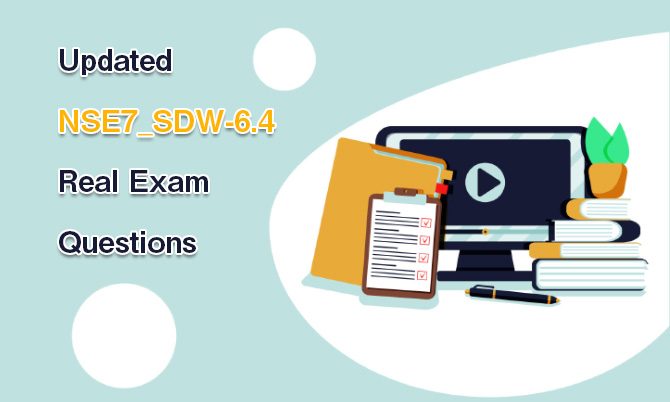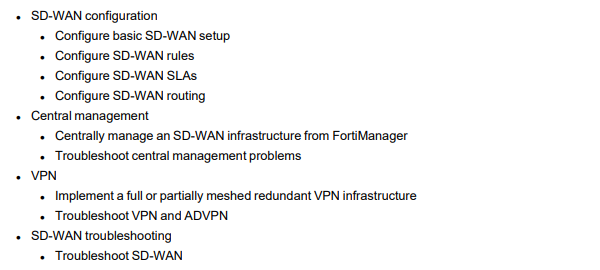Fortinet NSE 7 Network Security Architect NSE7_SDW-6.4 real exam questions have been updated, which are good material for you to pass the test. The Fortinet NSE 7-SD-WAN 6.4 exam is part of the NSE 7 Network Security Architect program, and recognizes the successful candidate's knowledge and expertise with the Fortinet SD-WAN solution. Fortinet NSE7_SDW-6.4 exam tests applied knowledge of the integration, administration, troubleshooting, and central management of a secure SD-WAN solution composed of FortiOS 6.4.0 and FortiManager 6.4.0.
Fortinet NSE7_SDW-6.4 exam is intended for network and security professionals who are responsible for the design, administration, and support of a secure SD-WAN infrastructure composed of many FortiGate devices.
Time allowed: 60 minutes
Exam questions: 35 multiple-choice questions
Scoring: Pass or fail, a score report is available from your Pearson VUE account
Language: English
Product version: FortiOS 6.4.0, FortiManager 6.4.0, FortiAnalyzer 6.4.0
Successful Fortinet NSE 7-SD-WAN 6.4 NSE7_SDW-6.4 exam candidates have applied knowledge and skills in the following areas and tasks.
All the new updated Fortinet NSE7_SDW-6.4 real exam questions can help you study the above Fortinet NSE 7-SD-WAN 6.4 exam topics. Share some updated NSE7_SDW-6.4 real exam questions and answers below.
1.What are two reasons why FortiGate would be unable to complete the zero-touch provisioning process? (Choose two.)
A. The FortiGate cloud key has not been added to the FortiGate cloud portal.
B. FortiDeploy has connected with FortiGate and provided the initial configuration to contact FortiManager
C. The zero-touch provisioning process has completed internally, behind FortiGate.
D. FortiGate has obtained a configuration from the platform template in FortiGate cloud.
E. A factory reset performed on FortiGate.
Answer: A,C
2.Which statement about using BGP routes in SD-WAN is true?
A. Adding static routes must be enabled on all ADVPN interfaces.
B. VPN topologies must be form using only BGP dynamic routing with SD-WAN
C. Learned routes can be used as dynamic destinations in SD-WAN rules
D. Dynamic routing protocols can be used only with non-encrypted traffic
Answer: C
3.Which two statements reflect the benefits of implementing the ADVPN solution to replace conventional VPN topologies? (Choose two)
A. It dynamically assigns cost and weight between the hub and the spokes, based on the physical distance
B. It creates redundant tunnels between hub-and-spokes, in case failure takes place on the primary links
C. It ensures that spoke-to-spoke traffic no longer needs to flow through the tunnels through the hub
D. It provides direct connectivity between all sites by creating on-demand tunnels between spokes.
Answer: C,D
4.Which three parameters are available to configure SD-WAN rules? (Choose three.)
A. Application signatures
B. Type of physical link connection
C. URL categories
D. Source and destination IP address
E. Internet service database (ISDB) address object
Answer: ADE
5.What are the two minimum configuration requirements for an outgoing interface to be selected once the SD-WAN logical interface is enabled? (Choose two)
A. Specify incoming interfaces in SD-WAN rules.
B. Specify outgoing interface routing cost.
C. Configure SD-WAN rules interface preference.
D. Select SD-WAN balancing strategy.
Answer: BC

